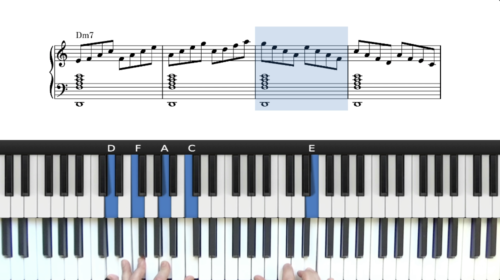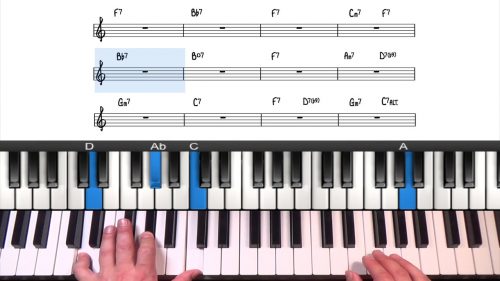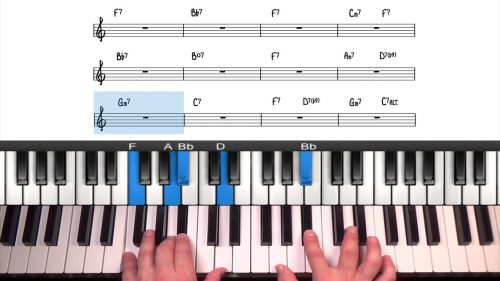Chord Tones Drills: Targeting The 3rd
In the first 2 lessons of this module we will explore a selection of chord tone drills to help us target the 3rds and 7ths. Whilst these exercises may appear to be simple, targeting the chord tones is an essential component of improvisation as we will see in the upcoming lessons.
Why Are Chord Tones Important?
Chord tones – particularly 3rds and 7ths – are ideal ‘landing places’ to finish our improvised lines. In addition these tones can be used as resting points which allows our improvisations to breath and also creates space in between our improvised phrases.
These drills and exercises will help you to visualise the chord tones from a melodic standpoint. We are going to perform these drills over a stride left hand style. The stride left hand will outline the harmony and also create a steady pulse over which we can improvise with our right hand melodies.
The 3 Types Of Approach Patterns
In this lesson we explore 3 types of approach patterns which can be used to target the 3rd of each chord in the A Section of “Misty”. The 3 types of approach pattern that we will cover are:
- Diatonic Approach Patterns
- Chromatic Approach Patterns
- Single & Double Note Enclosures
In the next lesson we will repeat the same drills but this time targeting the 7th of each chord.
Lesson Downloads
-
Targeting 3rds Exercise Notation File Type: pdf
Practice Tips
-
Complete these drills at a slow tempo, focus on accuracy, and keep a steady pulse in the left hand.
-
Start with the diatonic approach from above and once this drill can be performed accurately move onto the next drills.
-
Once each drill can be performed accurately, begin to mix and match the approach patterns as you cycle around the A Section of the tune.








Hi Hayden,
I don’t understand the minor scales you are using in this exercise. You play WHWWWHW, but I understood the natural minor harmonic is WHWWHWW, the harmonic minor is WHWWHWH, and melodic minor is WHWWWWH.
So what scale are you exactly playing in this exercise?
Hi Henk,
Good question.
I am using the Dorian Mode which is the 2nd mode of the major scale. This is the most common scale/mode to use when improvising over minor chords.
The 2 ways to view this mode are:
– the major scale with the b3 and the b7
– the major scale built a whole step below
For example, to play the Bb Dorian Mode, I could visualise the Bb major scale, with the flat 3 (Db) and the b7 (Ab).
The other method is to think of the major scale of the Imaj7 chord, for example, Bb-7 is the ii-7 chord in the 251 in Ab Major, and so the Bb Dorian mode contains the exact same notes as the Ab major scale but starting and ending on Bb. This is known as ‘the parent scale approach’.
Both of these methods work.
You might like to check out this foundation course lesson where we cover exercises to learn the Dorian mode and other important theory in all 12 keys: pianogroove.com/jazz-piano-lessons/essentials-practice-guide-simplified/
I’d recommend running through this practice planner every other day and this will give you the ‘essentials’ needed to understand these improvisation lessons.
I am also adding some downloads to this course which will be ready soon and so I will add a PDF which has the scale choices.
Let me know if I can help further and enjoy the lessons!
Cheers,
Hayden
In bar 5, for Cm7 you suggest instead C7. In the PDF you alter this to C7(b9). Targeting both the 3rd and the 7th diatonically with this alteration produce what to my ear seem unpleasing discords using C myxolydian scale for improvisation. Is it better to use a different scale for improvisation where the b9 alteration to the dominant 7th is notated?
Hi Graham.
Great question!
Yes you are correct that when we add the b9 into a dominant chord, the associated chord scale changes. In particular, you are hearing a clash from the b9 in the chord voicing, and the natural 9th that you are playing in the melody.
I would recommend to use the the C Altered Mode which contains the Root, b9, #9, 3, #11, #5/b13 and b7.
Another option is to omit the b9 from the left hand voicing. Remember that alterations are an optional addition.
This is why simply playing the 3rd and 7th in our left hand can be a good choice because it gives the most freedom to our right hand in terms of the notes that we can play in our improvised lines.
The most important thing to remember is that if you alter the 9th in the left hand voicing by playing either the b9 or the #9, then generally we should avoid the natural 9th in our melody as this creates a dissonant half step interval.
If we play an altered voicing in the left hand, for the C7 as an example, then targeting an individual alteration, or using an altered arpeggio pattern in the right hand can be a good choice, as we explore in the lessons in this course:
pianogroove.com/jazz-piano-lessons/altered-arpeggio-patterns/
pianogroove.com/jazz-piano-lessons/targeting-individual-alterations/
So that’s my main recommendation here; understand that the voicing that you choose in the left hand affects the ‘available melody notes’ in our right hand lines.
If you play an alteration in your left hand voicing, then using an altered melody line will work.
If you play a simple 3-7 voicing in the left hand, then you can choose between a simple diatonic approach into the 3rd of the 7th using the natural 9th as an approach pattern, or if you wish, you can include alterations too as an unaltered 3-7 left hand voicing can support an altered melody.
I hope that makes sense and let me know if you have any follow up questions.
Cheers,
Hayden
Thank you for clarifying the point in detail. I’m new to the altered scale, which seems to consist of the major scale with all possible alterations, is that correct? I ask because if so it would help a lot in constructing the altered scale in other keys. By the way I absolutely love the sound of the scale, can’t stop playing it endlessly up and down the keyboard! Oddly, it seems to sound more like a Db scale than a C scale.
Hi Graham,
Yes that’s exactly how I like to look at it, the major scale, or the mixolydian mode with all possible alterations.
A related area for you to explore is altered scale resolution points, I created a lesson on that here: pianogroove.com/jazz-piano-lessons/hearing-resolving-altered-tensions/
For any alteration on a V7 chord, there is always 1 or sometimes 2 options to resolve chromatically – either up or down – into the 1 chord.
It’s useful to be able to visualise and also ‘hear’ these resolution points and then you can let your ears guide you when you are using altered sounds over dominant chords. The lesson above explains this in more detail.
The altered mode can be very tense and jarring, and so knowing how to resolve this tension cleanly and smoothly is very important.
I hope that helps and have fun practicing this!
Talk soon, cheers,
Hayden
Unfortunately I am unable to access the altered scale lesson you mention as it is not included in the Cocktail Piano course to which I have subscribed. Thank you for your reply on my basic point however.
Hi Hayden, the three-page Targeting The 3rds pdf includes transcriptions of three of the drills or exercises; the Diatonic above approach, Chromatic above approach, and Chromatic enclosure exercise. Transcriptions of the other drills/exercises are not included. Just wondering if that’s what was meant, or if some of the document is missing?
I have a four-page pdf, but page 2 of the document has been repeated and page 3 is missing.
Hey Robert 👋
Indeed the 2nd page was duplicated by accident. Thanks for letting me know about this.
I have fixed the duplication and re-uploaded the PDF file.
Please download the file again and you will see that page 3 of the document now contains the following drills:
“Diatonic below approach exercise” and “Chromatic below approach exercise”.
Let me know if I can help further and enjoy the lessons!
Talk soon,
Hayden
Is it recommended that these exercises be played fluently up to speed (1x) before moving on to the next one?